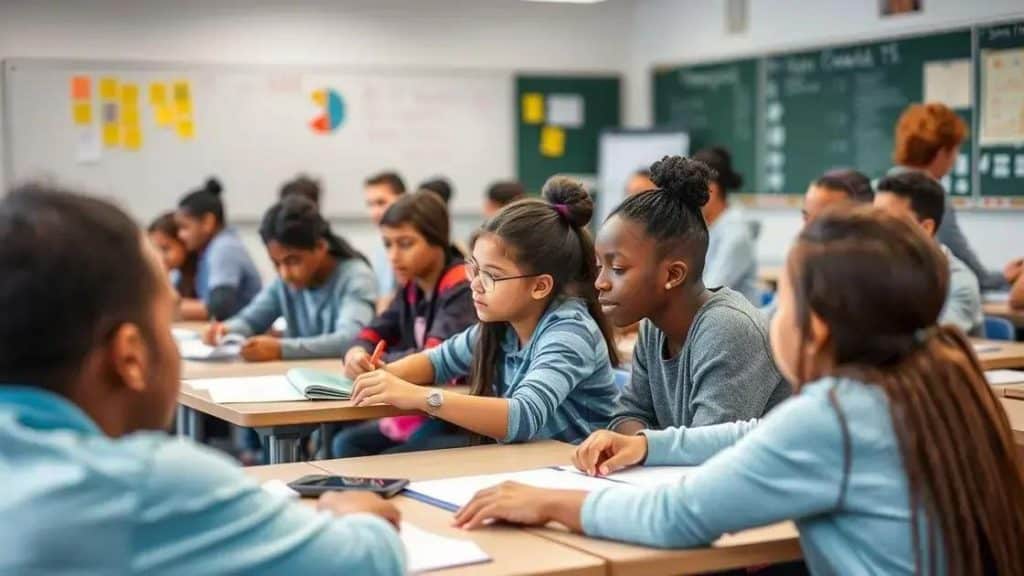Where education reform insights can reshape learning

Future directions for education reform emphasize technology integration, equity in access to quality education, social-emotional learning, and enhanced collaboration among stakeholders to improve student outcomes.
Where education reform insights offer valuable perspectives on improving the learning experience. Have you ever wondered how these changes impact students and teachers alike? In this article, we’ll dive into the significance of educational reforms and their real-world implications.
Understanding the importance of education reform
Understanding the importance of education reform is crucial for improving the learning experiences of students. Effective reforms can lead to better educational outcomes and equip students with essential skills for their future. It’s interesting to see how these changes can transform our education system.
Why Education Reform Matters
Education reform is not just about changing policies; it’s about making a significant impact on the lives of students and communities. Schools that embrace reform can respond more effectively to the needs of their students.
Key Benefits of Education Reform
- Enhances student engagement and motivation.
- Improves teaching methodologies.
- Addresses educational disparities.
- Prepares students for a global economy.
In addition, when educators and policymakers focus on reform, they foster an environment where innovation can thrive. Students are encouraged to explore creative solutions to real-world problems, paving the way for new ideas and perspectives.
Another vital aspect of education reform is the role of technology. Integrating modern technologies into classrooms can create interactive and personalized learning experiences. As a result, students learn better and retain more information when they engage with content that resonates with them.
Challenges in Implementing Education Reform
Implementing these changes can be challenging, however. Resistance to change, limited resources, and varying stakeholder interests often impede progress. Recognizing these obstacles is the first step toward effectively addressing them.
In conclusion, education reform is essential for developing a future-ready workforce. As we understand more about its importance, we can advocate for initiatives that promote better educational practices.
Key trends in education reform
Understanding key trends in education reform helps educators, policymakers, and communities adapt to the changing landscape of learning. These trends shape how we deliver education and prepare students for success.
Personalized Learning
One major trend is personalized learning. This approach tailors education to meet the individual needs of each student. By recognizing that students learn differently, schools can create customized lessons that cater to various learning styles.
Emphasis on STEM Education
Another important trend is the growing emphasis on STEM (Science, Technology, Engineering, and Mathematics) education. Schools are integrating more STEM programs to prepare students for careers in high-demand fields. This focus encourages analytical thinking and problem-solving skills.
- Increased funding for STEM initiatives.
- Partnerships with local businesses for real-world experience.
- Integration of technology in the classroom.
- Encouragement of girls and minorities to pursue STEM.
Technology integration continues to be a significant factor in education reform. With the rise of digital tools, classrooms are becoming more interactive and engaging. Students are learning to use technology effectively, which is critical in today’s job market.
Social-emotional learning (SEL) is also gaining traction as an essential part of education reform. Schools are implementing programs that address students’ mental health and emotional well-being. SEL helps students develop skills like empathy, resilience, and teamwork that go beyond academics.
Furthermore, there is a shift toward more inclusive education practices. Schools are focusing on creating environments where all students, regardless of their backgrounds or abilities, can thrive. This includes adapting curricula and providing additional support for students with disabilities.
Case studies: Successful education reform initiatives

Exploring case studies of successful education reform initiatives provides valuable insights into what works in transforming schools. These examples demonstrate how effective strategies can lead to significant improvements in student learning.
Example 1: The Charter School Movement
The charter school movement has been a prominent example of education reform. Charter schools operate independently of traditional school districts, allowing for innovative teaching methods. Many charter schools have shown remarkable success in boosting student performance, particularly in underserved communities.
Example 2: Finland’s Education System
Finland is often cited as a model for education reform. It prioritizes equal opportunities for all students and emphasizes teacher training. Finnish students enjoy shorter school days and less homework, yet achieve high academic success. This approach challenges traditional views on the education process.
- Focus on student well-being.
- Highly qualified teachers with autonomy.
- Curriculum flexibility.
- Minimal standardized testing.
Another successful initiative is the implementation of technology in classrooms. For instance, schools that have integrated digital learning tools have observed improved student engagement. These tools not only make learning more interactive but also allow for personalized educational experiences.
The “Teach For America” program represents a notable case of reform aimed at closing the achievement gap. By placing motivated leaders in low-income schools, TFA has made a significant impact on student outcomes. Teachers report feeling empowered to address the unique challenges of their classrooms, fostering a culture of high expectations for all students.
Furthermore, programs focusing on social-emotional learning (SEL) have shown positive results in various districts. By teaching students skills such as empathy and resilience, schools create a more supportive environment that enhances academic performance.
Barriers to effective education reform
Identifying the barriers to effective education reform is crucial for implementing successful changes. Understanding these challenges helps educators and policymakers navigate the complexities of reform efforts.
Resistance to Change
One major barrier is the resistance to change. Many educators and administrators may be hesitant to adopt new methods due to comfort with existing practices. This reluctance can slow down the adoption of innovative strategies essential for reform.
Lack of Funding
Another significant challenge is funding. Many schools face budget constraints that limit their ability to implement new programs and provide necessary training. Without adequate financial resources, even the best reform initiatives may struggle to succeed.
- Insufficient funding for teacher training.
- Limited access to teaching materials and technology.
- Challenges in maintaining facilities.
- Restricted opportunities for community involvement.
In addition to these factors, a lack of collaboration among stakeholders can hinder progress. When teachers, parents, and community members do not work together, it becomes difficult to create a cohesive approach to education reform. Effective communication and collaboration are essential for overcoming this barrier.
Political influences also play a significant role. Changes in leadership can shift priorities, affecting ongoing reform efforts. When political agendas focus on short-term goals, long-term educational improvements can be overlooked.
Finally, measuring the success of reforms can be challenging. If there are no clear metrics or methods to evaluate progress, it becomes difficult to determine whether the changes are effective. Establishing solid evaluation frameworks is vital for understanding the impact of education reform.
Future directions for education reform
Exploring the future directions for education reform can provide insights into how education will evolve in the coming years. As society changes, so do the needs of students and the focus of educational initiatives.
Integration of Technology
One significant trend is the continued integration of technology in educational settings. With the rise of remote learning, schools are implementing blended learning models that combine online and in-person education. This approach allows for more personalized learning experiences, meeting the needs of individual students.
Focus on Equity
Another direction involves a strong emphasis on equity in education. Schools are starting to create environments that ensure all students have access to quality resources and learning opportunities, regardless of their background. This push for equity aims to close the achievement gap that has persisted for many years.
- Implementing policies that support underserved communities.
- Providing additional resources for schools in low-income areas.
- Encouraging diverse hiring practices for educators.
- Fostering inclusive classroom environments.
Moreover, the future of education reform will likely prioritize social-emotional learning (SEL). This focus will help students develop essential skills such as self-awareness, empathy, and resilience. Educators will integrate SEL into the curriculum to prepare students not just academically, but also emotionally.
Collaboration among schools, families, and communities will also be key to future reforms. Engaging all stakeholders in the education process will lead to better outcomes. Schools will work on building partnerships with parents and local organizations to create more comprehensive support systems for students.
Additionally, redefining assessment practices is a crucial direction for education reform. Moving away from standardized testing, schools are exploring alternative assessment methods to evaluate student progress more holistically. These methods will consider creativity, critical thinking, and problem-solving abilities.
In conclusion, the future of education reform holds exciting possibilities. By focusing on technology integration, equity, social-emotional learning, collaboration, and innovative assessment methods, schools can create a more engaging and supportive learning environment. As we move forward, these key elements are essential for preparing students to succeed in an ever-changing world. Embracing these reforms will empower educators, involve families, and ultimately enhance student outcomes.
FAQ – Questions About Future Directions for Education Reform
What is the role of technology in future education reforms?
Technology will play a crucial role, enhancing personalized learning and enabling innovative teaching methods to engage students more effectively.
How does education reform aim to achieve equity?
Future reforms focus on ensuring that all students, regardless of their backgrounds, have equal access to quality education and resources.
What is social-emotional learning (SEL) and why is it important?
SEL helps students develop critical life skills, such as empathy and resilience, preparing them to succeed academically and socially.
How can collaboration improve education reform efforts?
Collaboration among schools, families, and communities fosters support systems that enhance student learning and overall educational outcomes.





